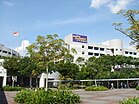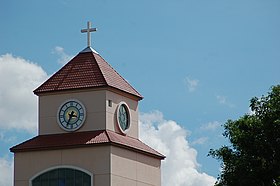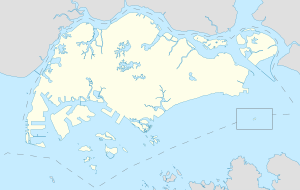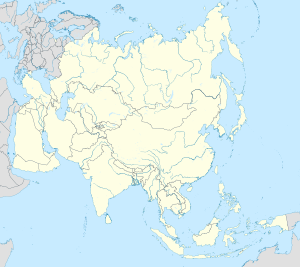
Back آنگ مو کیو Persian आंग मो किओ Hindi Ang Mo Kio ID अंग मो क्यो Marathi อังโมเกียว Thai 宏茂桥 Chinese Âng-mô͘-kiô ZH-MIN-NAN 宏茂橋 ZH-YUE
Ang Mo Kio | |
|---|---|
| Others transcription(s) | |
| • Chinese | 宏茂桥 (Simplified) 宏茂橋 (Traditional) Hóngmàoqiáo (Pinyin) Âng-mô͘-kiô (Hokkien POJ) |
| • Malay | Ang Mo Kio |
| • Tamil | ஆங் மோ கியோ Āṅ mō kiyō (Transliteration) |
From top left to right: Bishan-Ang Mo Kio Park, Nanyang Polytechnic, Mayflower MRT station, ITE College Central, AMK Hub, Clock tower of Presbyterian High School | |
 Location of Ang Mo Kio in Singapore | |
| Coordinates: 01°22′12″N 103°50′44″E / 1.37000°N 103.84556°E | |
| Country | |
| Region | Central Region
|
| CDC | |
| Town council |
|
| Constituencies | |
| Town announced |
|
| Town completed |
|
| DGP exhibited |
|
| PA incorporated |
|
| Government | |
| • Mayors | Central Singapore CDC
|
| • Members of Parliament | Ang Mo Kio GRC
Kebun Baru SMC Yio Chu Kang SMC |
| Area | |
• Total | 13.94 km2 (5.38 sq mi) |
| • Rank | 18th |
| • Residential | 2.83 km2 (1.09 sq mi) |
| Population | |
• Total | 159,340 |
| • Rank | 11th |
| • Density | 11,000/km2 (30,000/sq mi) |
| • Rank | 16th |
| Ethnic groups | |
| • Chinese | 134,350 |
| • Malays | 11,140 |
| • Indians | 12,810 |
| • Others | 3,970 |
| Postal district | 20 |
| Dwelling units | 49,169 |
| Projected ultimate | 58,000 |
Ang Mo Kio (IPA: /ɑːŋ moʊ kjoʊ/ is a planning area and residential town situated in the Central Region of Singapore.[a] Located approximately 11 km (6.8 miles) north of the Downtown Core district, Ang Mo Kio is the 3rd most populated planning area in the North-East region and ranks 8th in terms of population in the country overall.[4][8] The planning area is located at the south-western corner of the North-East region, bordered by the planning areas of Yishun to the north, Sengkang to the north-east, Serangoon to the east, Bishan to the south and the Central Water Catchment to the west.[9]
Prior to urbanization, the area, much like other rural districts in Singapore at the time, was largely undeveloped, being mainly used for agricultural purposes, with uninhabited plots of land usually covered in dense secondary forest or swamps.[10] Ang Mo Kio was subsequently redeveloped by the Housing and Development Board (HDB) in 1973 as their seventh satellite town and the first to be built in metric dimensions,[2][10] being fully completed by 1980. The first three town councils in the country were established in Ang Mo Kio in 1986, as part of a pilot project to better serve residents of HDB new towns. The concept eventually became adopted under the Town Council Act of 1988 which today, remains as the second-level of administration in Singapore.[11][12]
Ang Mo Kio today, much like its neighbouring towns, is largely urbanized. However, parks are still prevalent in the town as part of the country's green initiative. Parks include Ang Mo Kio Town Garden East and Ang Mo Kio Town Garden West. Although not technically located within Ang Mo Kio itself, the Bishan-Ang Mo Kio Park in the adjacent town of Bishan was designed to serve residents of both towns. The park itself straddles along the Ang Mo Kio–Bishan boundary, making it easily accessible from Ang Mo Kio.
- ^ "The next new town: Ang Mo Kio". The Sunday Times. 5 August 1973.
- ^ a b "Singapore Infopedia: Ang Mo Kio". National Library Board.
- ^ a b "Singapore Infopedia - Development guide plan". National Library Board.
- ^ a b c "Ang Mo Kio (Planning Area, Singapore) - Population Statistics, Charts, Map and Location". www.citypopulation.de.
- ^ "FlipViewer Xpress". www10.hdb.gov.sg. Archived from the original on 4 March 2016.
- ^ "Land Area and Dwelling Units by Town". Data Singapore. 2016. Retrieved 26 January 2018.
- ^ "Singapore Residents by Planning Area / Subzone, Age Group, Sex and Type of Dwelling, June 2024". Retrieved 5 January 2025.
- ^ a b "Singapore Residents by Planning Area/Subzone, 2015". Singapore Department of Statistics. Archived from the original (XLS) on 10 June 2016. Retrieved 20 May 2016.
- ^ [1] Archived 5 March 2016 at the Wayback MachineSingapore Department of Statistics - Planning Areas/Subzones in Singapore (Year 2015)
- ^ a b [2] Archived 23 October 2015 at the Wayback MachineNational Heritage Board. Ang Mo Kio Heritage Trail
- ^ "HDB Towns, Our Home: Ang Mo Kio". Housing and Development Board.
- ^ "Singapore Infopedia: Singapore's first town councils". National Library Board.
Cite error: There are <ref group=lower-alpha> tags or {{efn}} templates on this page, but the references will not show without a {{reflist|group=lower-alpha}} template or {{notelist}} template (see the help page).








